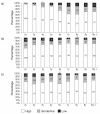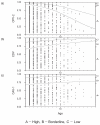Antibody titers for canine parvovirus type-2, canine distemper virus, and canine adenovirus type-1 in adult household dogs
- PMID: 22379198
- PMCID: PMC3157073
Antibody titers for canine parvovirus type-2, canine distemper virus, and canine adenovirus type-1 in adult household dogs
Abstract
Serum antibody titers for canine parvovirus type-2 (CPV-2), canine distemper virus (CDV) and canine adenovirus type-1 (CAV-1) were investigated in 1031 healthy adult household dogs (2 to 18 years old) given an annual inoculation in the previous 11 to 13 months. The number of dogs retaining significant titers of antibodies against CPV-2, CDV, and CAV-1 were 888 (86%), 744 (72%), and 732 (71%), respectively. There were no differences between males and females in antibody titers against the 3 viruses. Antibody titer for CPV-2 was significantly higher in younger dogs than in older dogs, CDV antibody was significantly higher in older dogs than in younger dogs, and CAV titer was not associated with age.
Taux d’anticorps anti-parvovirus canin de type 2, anti-virus de la maladie de Carré et anti-adénovirus canin de type 1, chez les chiens de compagnie adultes. Les taux de rétention d’anticorps sériques de la parvovirose canine (CPV-2), de la maladie de Carré (CDV) et de l’encéphalite de Rubarth — type-1 (CAV-1) ont été mesurés chez 1031 chiens de compagnie adultes en bonne santé. Les nombres de chiens ayant un taux conséquent d’anticorps CPV-2, CDV et CAV-1 ont été respectivement de 888 (86 %) de 744 (72 %) et de 732 (71 %). Nous n’avons pas noté de différence sexuelle significative pour les taux d’anticorps CPV-2, CDV et CAV-1. Par groupe d’âge les taux d’anticorps CPV-2 sont plus élevés de façon significative chez les jeunes chiens que chez les chiens plus âgés, et ceux de CDV sont significativement plus élevés chez les chiens âgés que chez les chiens plus jeunes. Les taux de CAV ne sont pas en relation avec l’age.
(Traduit par les auteurs)
Figures
Similar articles
-
Assessment of serum antibody titers against canine distemper virus, canine adenovirus type II, and canine parvovirus in Alaskan sled dogs before and after a long-distance race.J Am Vet Med Assoc. 2008 Jun 1;232(11):1669-73. doi: 10.2460/javma.232.11.1669. J Am Vet Med Assoc. 2008. PMID: 18518808
-
Viral antibodies in coyotes from California.J Wildl Dis. 1998 Apr;34(2):259-64. doi: 10.7589/0090-3558-34.2.259. J Wildl Dis. 1998. PMID: 9577772
-
A serologic survey for antibodies to three canine viruses in wolverines (Gulo gulo) from the Brooks Range, Alaska.J Wildl Dis. 2005 Oct;41(4):792-5. doi: 10.7589/0090-3558-41.4.792. J Wildl Dis. 2005. PMID: 16456170
-
Canine viral vaccines at a turning point--a personal perspective.Adv Vet Med. 1999;41:289-307. doi: 10.1016/s0065-3519(99)80022-6. Adv Vet Med. 1999. PMID: 9890023 Free PMC article. Review.
-
Canine parvovirus vaccination and immunisation failures: Are we far from disease eradication?Vet Microbiol. 2020 Aug;247:108760. doi: 10.1016/j.vetmic.2020.108760. Epub 2020 Jun 15. Vet Microbiol. 2020. PMID: 32768213 Free PMC article. Review.
Cited by
-
Serosurvey of rabies virus, canine distemper virus, parvovirus, and influenza virus in military working dogs in Korea.J Vet Med Sci. 2018 Sep 13;80(9):1424-1430. doi: 10.1292/jvms.18-0012. Epub 2018 Jul 31. J Vet Med Sci. 2018. PMID: 30068896 Free PMC article.
-
Prevalence of Neutralizing Antibodies to Canine Distemper Virus and Response to Vaccination in Client-Owned Adult Healthy Dogs.Viruses. 2021 May 20;13(5):945. doi: 10.3390/v13050945. Viruses. 2021. PMID: 34065493 Free PMC article.
-
Canine morbillivirus (CDV): a review on current status, emergence and the diagnostics.Virusdisease. 2022 Sep;33(3):309-321. doi: 10.1007/s13337-022-00779-7. Epub 2022 Aug 25. Virusdisease. 2022. PMID: 36039286 Free PMC article. Review.
-
Prevalence of Serum Antibody Titers against Core Vaccine Antigens in Italian Dogs.Life (Basel). 2023 Feb 20;13(2):587. doi: 10.3390/life13020587. Life (Basel). 2023. PMID: 36836944 Free PMC article.
-
Canine Distemper Virus: Origins, Mutations, Diagnosis, and Epidemiology in Mexico.Life (Basel). 2024 Aug 13;14(8):1002. doi: 10.3390/life14081002. Life (Basel). 2024. PMID: 39202744 Free PMC article. Review.
References
-
- Lamm CG, Rezabek GB. Parvovirus infection in domestic companion animals. Vet Clin North Am Small Anim Pract. 2008;38:837–850. - PubMed
-
- Martella V, Elia G, Buonavoglia C. Canine distemper virus. Vet Clin North Am Small Anim Pract. 2008;38:787–797. - PubMed
-
- Eugster AK, Bendele RA, Jones LP. Parvovirus infection in dogs. J Am Vet Med Assoc. 1978;173:1340–1341. - PubMed
-
- Baba M, Yasoshima A, Kojima A, et al. Canine parvovirus infection in a group of beagles. Exp Anim. 1981;30:141–144. - PubMed
MeSH terms
Substances
LinkOut - more resources
Full Text Sources
Other Literature Sources


